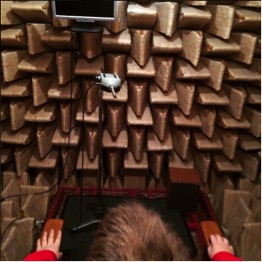
If you search on the Web of Science database for papers on the emotion of fear, you’ll get back 6,477 published papers. Search for papers on laughter and you’ll get a paltry 175. Why the disparity? Well, one reason might be that laughter, like other positive emotions, feels less important than negative emotions. Sometimes people think that laughter is a ridiculous, trite, pointless topic to research — and somehow not the sort of topic we should study with Science with a capital S.
I’m a cognitive neuroscientist who works on vocal communication, and I (perhaps unsurprisingly) disagree. I have started to look into laughter in more detail, and I think it’s a fascinating social behavior it is essential to study (here’s an article I wrote for The Psychologist, a paper for The Journal of Neuroscience, and another for Cerebral Cortex). However, there is another reason why it is extremely hard to study laughter scientifically, and that’s because it is exceptionally difficult to make people laugh in the lab.
This is partly because we normally laugh in social settings — social settings that can be extremely hard to re-create, for example, in a sterile anechoic chamber. But we need to use the anechoic chamber to make good, clear recordings of people laughing on their own, uncontaminated by the sounds of other people.

The anechoic chamber at University College London, where I work, is almost epically unamusing. It is claustrophobic and unpleasant. It’s all I can do to spend two minutes in there, let alone start laughing there. But obviously our research calls for us to study people genuinely laughing. So over time we have learned the hard way how to make people laugh.
As with live TV shows and comedy clubs, we “warm people up” by spending time with them, watching stuff and laughing together, until we’re ready to throw them into the chamber to start recording their mirth. There is some science behind this: Laughter is contagious, and it’s much easier to make someone laugh again if they’re already laughing. So we try and get groups of people to come in at once, and if possible, groups of people we know, and who know each other. We are thirty times more likely to laugh if we’re with someone else than if we’re on our own, and we’re more likely to “catch” laughter from someone we know than someone we don‘t know.
We still need reasons for people to laugh when they’re in the chamber, and here YouTube has been our greatest friend. Here are some of the videos we have used to make people laugh, roughly grouped into six categories.
1. Laugh and the world laughs with you
Here we use the contagion of laughter to make people laugh. So the Skype laughter chain is a great sequence of people laughing because other people are laughing. Meanwhile, another goldmine of giggles is the genre of TV or radio presenters trying not to laugh. There is something truly wonderful about people presenting live who have to try and keep talking through their laughter.
2. Schadenfreude
Empirically, if you ask German people what makes them laugh, they are most likely to talk about schadenfreude – which means “harm-joy,” and which generally means laughter caused by someone else’s misfortune, like this Dublin pedestrian falling on ice. English-speaking people don’t have a good word for schadenfreude, but a fondness for slapstick humor and pratfalls suggests we are just as likely to laugh at it.
3. Schadenfreude AND laughter
I use this video to show how swiftly laughter changes a mood. Also, what a glorious pratfall, followed by helpless laughter.
4. Situation comedy
Although most laughter is found in social interactions, clips from sitcoms can be a very useful cue for laughter – especially some of the very rapid “best of” edits, such as Troy from Community or Dr. Tobias Fünke from Arrested Development.
5. Specialist interest
What we find funny can be intensely personal. Carolyn McGettigan, who used to work in my lab, has an extensive and thorough knowledge of the Eurovision Song Contest. This includes some of the more unusual performances, for example: Krassimir from Bulgaria in 2009. Starts oddly, then, stilts! It makes her cry with laughter.
6. Social priming
No matter what I did, I could not laugh on my own in the anechoic chamber. I would sit and watch things (or read things) and chuckle gently, at best. What made me laugh out loud was watching Carolyn listening to something that made her want to laugh. Then I laughed extremely hard.
It’s worth noting that though some themes emerge, there is no one thing (video, clip, story) that everyone finds funny. When I give talks to the University of the Third Age (a university for retired and semi-retired people), for example, very few people find the clip of the Dublin pedestrian slipping and falling funny, because older people are more acutely aware of the realities of falling. This context-dependent effect in humor has probably never been better expressed than by The Onion in an article titled “That’s not funny: my brother died that way.” Which made me laugh.
Featured image via iStock.












